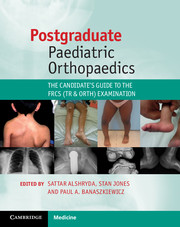Book contents
- Frontmatter
- Contents
- List of contributors
- Foreword
- Preface
- Acknowledgements
- Interactive website
- List of abbreviations
- Section 1 General guidance
- Section 2 Core structured topics
- Chapter 3 The hip
- Chapter 4 The knee
- Chapter 5 The foot and ankle
- Chapter 6 The spine
- Chapter 7 The shoulder
- Chapter 8 The elbow
- Chapter 9 Congenital hand deformities
- Chapter 10 Neuromuscular diseases
- Chapter 11 Musculoskeletal infections
- Chapter 12 Musculoskeletal tumours
- Chapter 13 Skeletal dysplasia
- Chapter 14 Metabolic bone disease
- Chapter 15 Physis and leg length discrepancy
- Chapter 16 Deformity corrections
- Chapter 17 Miscellaneous paediatric conditions
- Section 3 Exam-related material
- Index
- References
Chapter 17 - Miscellaneous paediatric conditions
Published online by Cambridge University Press: 05 August 2014
- Frontmatter
- Contents
- List of contributors
- Foreword
- Preface
- Acknowledgements
- Interactive website
- List of abbreviations
- Section 1 General guidance
- Section 2 Core structured topics
- Chapter 3 The hip
- Chapter 4 The knee
- Chapter 5 The foot and ankle
- Chapter 6 The spine
- Chapter 7 The shoulder
- Chapter 8 The elbow
- Chapter 9 Congenital hand deformities
- Chapter 10 Neuromuscular diseases
- Chapter 11 Musculoskeletal infections
- Chapter 12 Musculoskeletal tumours
- Chapter 13 Skeletal dysplasia
- Chapter 14 Metabolic bone disease
- Chapter 15 Physis and leg length discrepancy
- Chapter 16 Deformity corrections
- Chapter 17 Miscellaneous paediatric conditions
- Section 3 Exam-related material
- Index
- References
Summary
Non-accidental injury
Background
Ambrose Tardieu first reported non-accidental injury (NAI) in 1860, noting the correlation between cutaneous lesions, fractures, subdural haematomas and death [1]. Caffey again highlighted the association between long bone fractures and subdural haematomas in 1946 [2]. However, it was Henry Kempe who raised the profile of NAI in 1962 when he coined the term ‘battered-child syndrome’ [3]. He described the association between multiple fractures, subdural haematomas, failure to thrive, soft-tissue swelling or bruising and sudden unexplained death. He also highlighted the importance of situations in which the type or degree of injury did not correlate with the history. The US Child Abuse Prevention and Treatment Act (CAPTA) defines child abuse and neglect as:
Any act or failure to act resulting in imminent risk of death, serious physical or emotional harm, sexual abuse or exploitation of a child by a parent or caretaker who is responsible for a child’s welfare.
Child abuse is more common than most would expect; it is estimated that 7% of children suffer serious physical abuse. Studies suggest that 25% of fatally abused children had been seen recently by a healthcare provider [4].
- Type
- Chapter
- Information
- Postgraduate Paediatric OrthopaedicsThe Candidate's Guide to the FRCS (Tr and Orth) Examination, pp. 249 - 262Publisher: Cambridge University PressPrint publication year: 2014



